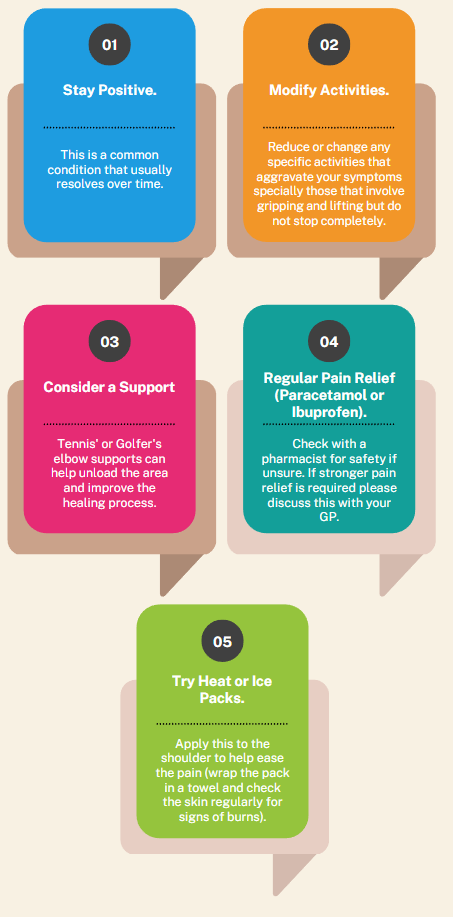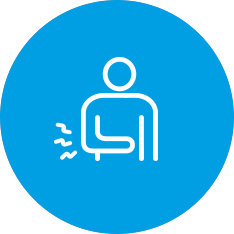Golfer's Elbow
What is Golfer's Elbow?
Golfer's elbow is a condition that causes pain on the inside of the elbow. It occurs when the tendon and muscles that bend the wrist and fingers become painful.
This happens when the stresses and loads placed on the tendon, through various activities, have been more than the tendon has been able to cope with.
It does not just affect golfers, but anyone who does repeated activities with their hands, wrists or arms.
What are the symptoms?
- The pain is often located around the bony part on the inside of the elbow but may spread slightly up and/or down the arm
- Pain on activities such as; gripping, shaking hands, lifting items with your palm facing up, twisting jars/lids, straightening the elbow
- Sometimes you have stiffness at the elbow and/or wrist
- Sometimes you may feel weakness in the wrist or elbow or have reduced grip strength
What are the causes?
The exact cause is not always known, but usually it is caused by any activity that places an increased demand on the tendon that it cannot cope with. Normally there is a good balance between the wear and repair processes when we use our tendons, however if this is disturbed and there is too much wear and not enough chance for repair, we start to get pain.
There are many factors that can increase your risk of developing golfer’s elbow such as:
- Sudden increase in load or demand placed on the muscles, such as: decorating a room, starting a new gardening or craft project
- Repetitive activities that continually overload the hand/wrist (e.g. work-related)
- Inactivity causing deconditioning of the muscles and tendons
- More common between ages 40-60
- May result from a trauma
- Smoking
- Being overweight
- Diabetes
- Depression and anxiety
- Rheumatoid Arthritis
- Thyroid problems
- Poor diet
For more information to help support your general health and well-being, please click here to access our "Healthy You" page. This includes information on exercise, mental health, smoking and weight management.
How long will it last?
Everyone's elbow pain is different and full recovery can depend on multiple factors, but most people will make a full recovery. Most people will see some improvement following 6-12 weeks of lifestyle changes, advice, and an exercise program. Tendon healing can be a slow process and can take up to 18-24 months to fully resolve.
What can I do to help myself?

What else can I do?
A gradual increase in load can help the tendon structure improve. We have provided some exercises in the links below. Start with the easiest and build up to the more advanced exercises as you feel able to.
Golfer's elbow exercises - EASY
Golfer's elbow exercises - MODERATE
Golfer's elbow exercises - ADVANCED
Do I need an x-ray or scan?
In most cases, no. A good history and physical examination of your elbow alone provides enough information to diagnose your problem. Scans and x-rays are not always useful for diagnosing golfer's elbow. While a scan or x-ray may provide information it rarely alters the treatment plan.
Imaging findings are very poorly linked with pain and often people with no pain have very similar findings on their scans/x-rays to those that do. X-rays and scans can help for a small number of people in certain situations and will be recommended by a healthcare professional if required.
Symptoms to check
Click the plus sign to see a list of problems that could be a sign you may need to be checked urgently
Get advice from 111 now if your arm/elbow:
- hurts when you exercise but the pain goes away when you rest
- you are experiencing chest pain/tightness with your elbow pain
- is swollen and you have a very high temperature or feel hot and shivery
- is extremely painful and difficult to move
- the pain is severe and started after an injury or accident, like a fall
- you have pins and needles or numbness that won’t go away
- has been injured and you heard a snapping noise or your arm has changed shape
111 will tell you what to do. They can tell you the right place to get help if you need to see someone.Go to 111.nhs.uk or call 111
Immediate medical advice is available by contacting NHS 111


 Elbow
Elbow